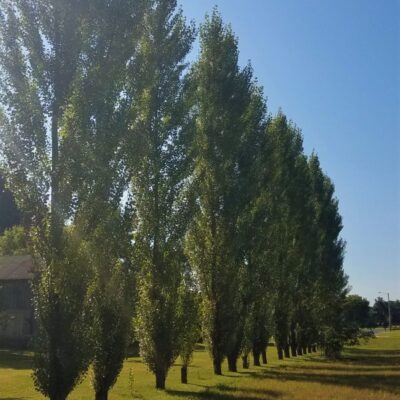Garden Plant: Lombardy Poplar
Product Description: Lombardy Poplar

Sophisticated, Dazzling Green Screen Lombardy Poplar
- Gorgeous Living Screen
- Fast Growth Rate
- Classic Columnar Tree
- Drought Tolerant
- Hardy
- Leaves Shimmer and Dance in the Breeze
- Works Across the United States
However you choose to use the beautiful Lombardy Poplar trees (Populus nigra Italica’), we know You’ll be pleased. It is one of the fast-growing trees used in wind breaks and as privacy screens.
People love these beautiful, fast-growing screening trees with their strongly columnar profile. There is something about a green column with branches held strongly upright that really catches your eye and adds character to any landscape.
Perhaps it’s the peaceful feeling you get standing near them. They’ll move your eye straight up and give you a grand sense of scale. Lombardy Poplars are fine-textured trees and feature a pleasing, symmetrical crown.
Large, heart-shaped, fluttering leaves are green on one side and silver on the other. It’s mesmerizing to watch their shimmering dance and hear their rustling sound in the slightest breeze. In fall, the leaves turn a classic shade of bright, autumn yellow.
Popular since the late 1700\’s, it’s hard to imagine the United States without this lovely tree lining streets and large landscapes.
Widely adaptable Poplars grow across the country. Birds love the shelter and high protection the Lombardy branches offer, so you will have plenty of songbirds coming to visit.
People love how fast they grow provide a quick privacy hedge. If you need to screen out an unwanted view, this tree can grow up to 6 feet a year. Very few other screening trees will grow as fast as a Lombardy Poplar.
For a fast-growing privacy boost, don’t buy just one. These trees have got you – or at least that ugly view – covered!
How to Use Lombardy Poplar in the Landscape
You have probably seen them planted in a row along the edges of large properties. Their leaves help trap and disperse the wind. They will also muffle traffic sounds.
Farmers love to plant them behind slower growing evergreen trees as effective wind and snow breaks. Try several in your landscape against the direction of your prevailing winds.
Tall and columnar, Lombardy Poplars create a memorable impact wherever they are planted, but especially if planted in a row. Planted at 5\’ to 8\’ apart, they will make a formidable windbreak in no time. You can zig-zag – or stagger – a series of planting rows for faster results.
Add the Lombardy Poplar with other trees and tall flowering shrubs to create a wonderful mixed planting. Include evergreens to gain cover all winter long. In winter, the Lombardy Poplar makes a strong visual statement with its bare branches held erect.
These stately trees have been used in public and private landscapes in Europe since the late 1600\’s. The trees begin to show up in the United States in the late 1700\’s, in a short amount of time they were being planted everywhere.
Andrew Jackson Downing, a renowned landscape designer and horticulturist in the 1800\’s, helped popularize them in America by extensively writing about their extraordinary habits and the many ways to use them. The wide range of climates that the tree would grow in only added to it popularity.
Lombardy Poplars have been used to dramatically line roadways. People also used them as tall backdrops for their garden borders. They easily highlight and define property lines.
Lombardy Poplar’s classic look will be a memorable compliment to most larger landscapes or businesses. Try a single tree as a wonderful landmark specimen.
Or, use multiples in an informal grouping in the far lawn. Mulch underneath and create an oblong, island garden bed. You’ll love the energetic vista – or view – created with these dynamic trees.
Pro Plant Tips for Care
Lombardy Poplar works beautifully in Zones 3-9. It is adapted to almost any soil it is planted in.
Plant in full sun for best performance. Give it regular water as a young tree.
It becomes a truly drought tolerant variety after its first few seasons. As ground water gets low in the late summer, the tree goes dormant to cut down its water needs. If you experience a very dry summer, You’ll see leaf drop early.
During times of extended drought, give it supplemental water, if you want to extend the life of the leaves. These cold hardy Poplars can handle occasional wet soils, too.
Very easy to grow and care for once established, plant Lombardy Poplar where it will have enough room to grow into its mature size. It is a large tree despite being narrow, so give it lots of room to thrive.
With shallow surface roots, it’s best to mulch underneath and create a garden bed. Plant it at least 40 feet away from pavement, leach fields and foundations.
Leave the lower branches on for a fuller screen from top to bottom. You’ll love the look.


